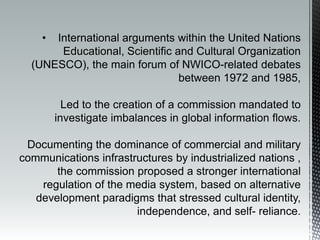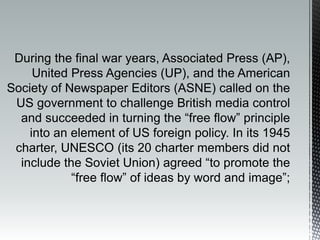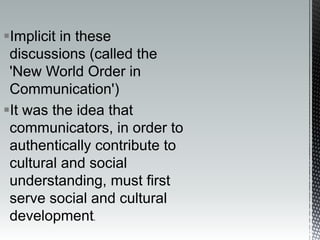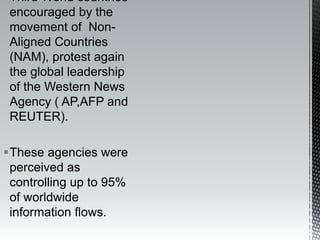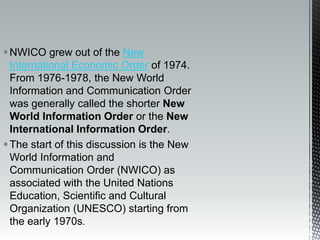Macbride presentation about nwico
- 2. • The MacBride Commission so- named for its president was officially design UNESCO's International Commission for the Study of Communication Problems
- 3. Many Voices One World, also known as the MacBride report, was a 1980 UNESCO publication written by the International Commission for the Study of Communication Problems. Its aim was to analyze communication problems in modern societies, particularly relating to mass media and news, and to suggest a new communication order to solve these problems to further peace and human development.
- 4. • The controversy around a New World Information and Communication Order (NWICO) is a key episode in the emergence of global communications governance.
- 5. Beginning in the 1960s, US efforts to maintain the “free flow of information” as a core principle in international communications were met with criticism from the Soviet Union and its allies as well as the Non-Alignment Movement (NAM) of independent states.
- 8. Actively promoted by UNESCO until 1983, NWICO contributed to the departure of two of its key members, the United States (1984) and the UK (1985).At the time of World War II, the British network of sea cables connected Australia, Canada, China, India, and South Africa to the imperial center and established a communications monopoly; British (Reuters) and French (Haves/French Information Office) press agencies controlled news flows to and from their colonies.
- 9. Implicit in these discussions (called the 'New World Order in Communication') It was the idea that communicators, in order to authentically contribute to cultural and social understanding, must first serve social and cultural development.
- 10. New International Information Order (NIIO) appeared during the 1970;s as a result of what they are perceived as their disadvantages situation in the field of information and communication.
- 11. Third World countries encouraged by the movement of Non- Aligned Countries (NAM), protest again the global leadership of the Western News Agency ( AP,AFP and REUTER). These agencies were perceived as controlling up to 95% of worldwide information flows.
- 12. NWICO grew out of the New International Economic Order of 1974. From 1976-1978, the New World Information and Communication Order was generally called the shorter New World Information Order or the New International Information Order. The start of this discussion is the New World Information and Communication Order (NWICO) as associated with the United Nations Education, Scientific and Cultural Organization (UNESCO) starting from the early 1970s.
- 13. A wide range of issues were raised as part of NWICO discussions. Some of these involved long-standing issues of media coverage of the developing world and unbalanced flows of media influence. But other issues involved new technologies with important military and commercial uses. The developing world was likely to be marginalized by satellite and computer technologies.
- 14. The United States was hostile to NWICO. According to some analysts, the United States saw these issues simply as barriers to the free flow of communication and to the interests of American media corporations. It disagreed with the MacBride report at points where it questioned the role of the private sector in communications. It viewed the NWICO as dangerous to freedom of the press by ultimately putting an organization run by governments at the head of controlling global media, potentially allowing for censorship on a large scale. From another perspective, the MacBride Commission recommendations requiring the licensing of journalists amounted to prior censorship and ran directly counter to basic US law on the freedom of expression.





